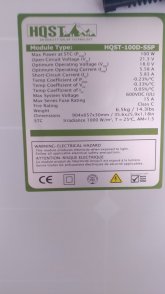It's always possible he had a faulty unit, the two I have work well enough. They are connected to about 1kW arrays each and reliably wake up in the morning and properly charge their respective batteries. One has charges lead acid, the other lithium. They are a bit inaccurate when it comes to battery voltage, it's a common enough theme in the cheaper end of the market, but you can compensate by adjusting the voltages the charger is set at for float and absorption. If you want to do anything more than basic configuration you will need bluetooth comms to a smartphone with their app, or a Windows PC connected to the serial port on the charger, or their remote panel. The port can be RS232 (proper RS232, swings +/- so you need a proper RS232 port for the PC not a TTL port) or RS485.
I'm guessing you have 12V class panels, so Vmp probably around 18V, Imp 5.5A. If your plan is to connect two panels in series then parallel those sets and then run back to the controller via the 10 AWG wiring you will be looking at around 11A maximum over the wire. The voltage drop at full power is minimal and nothing to worry about. 2 panels in series is better for a MPPT controller so unless you have shading issues that is how I would do things.
2 in series is preferable for MPPT unless you are trying to work around shading issues. If you plan on configuring the batteries for 24V you have no choice but to use 2 or more panels in series.
The Rover 40A li can handle up to 100VDC on the solar input. If you don't have low temperatures there you may just be able to sneak in putting them all in series too. That's no good for shading of course. If you want to look into this post the specs for your panels, the label on the back or the web site will do.





